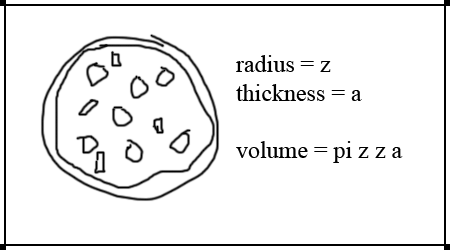| ddhr.org | ||||
|
||||
| Odd Day (2) | May 7, 2009 |
| Today, May 7, 2009 (05/07/09) is an Odd Day, one of six dates per century made up of three consecutive odd numbers. The six dates are: 01/03/05, 03/05/07, 05/07/09, 07/09/11, 09/11/13, 11/13/15. Until July 9, 2011, may the geek be with you. #math | |
| Negative numbers and fractional powers | Feb 10, 2009 | ||||||||||||||||
|
This is about math. If you don't like math, go play with your crayons and scissors or whatever it is you people do. It has come to my attention through a series of failures that different math processing machines compute negative numbers raised to certain fractional exponents differently. The math processing machines I'm talking about are my TI-86 calculator, Microsoft Excel 2003, and Matlab 2007. This is best illustrated with the following table:
To avoid overstating the issue, let me assure you the pattern continues. In fact, the pattern is as follows: (x)^(y/z) is real for all negative real x, all positive whole y, and all positive whole odd zIf any of those conditions isn't met, the result will be imaginary, which isn't necessarily a bad thing, but after a brief five-year career in engineering, I still haven't discovered the purpose of imaginary numbers. Echoing what I found, SparkNotes says, "Since we cannot take the even root of a negative number, we cannot take a negative number to a fractional power if the denominator of the exponent is even." This is because any fraction with an even denominator can be broken down into [something] × 1/2, which yields an imaginary result. #math |
|||||||||||||||||
| Conception calculation (3) | Oct 27, 2008 |
| I know some people who have the extremely awkward habit of calculating the approximate date and most-likely special event that led to a person's conception. For example, it will be stated that a person's birthday is in September, at which point said "conception calculator" will think for a few seconds then blurt out with a grin, "A Christmas baby, eh?" This is especially uncomfortable when family is involved, which it almost always is. #math | |
| Auto-ordered plates (10) | Oct 1, 2008 |
|
If there was ever a doubt as to how much of a geek I am, this should make it clear. Our household owns several different colors of solid-color plates. Two each of red, orange, yellow, and blue. We use these plates in a random order, i.e. we don't intentionally use plates of the same color for a meal for two. Furthermore, the order of the plates is constantly changing (and randomly, at that) because the order in which they're used isn't the order in which they're replaced, and sometimes newly washed plates are placed on top of the pile, while other times they're placed at the bottom. If anything can be said about the usage of these plates, it's that it's completely random. There's no order involved whatsoever. Which makes it interesting when something like this happens:  What we have here is a set of eight plates that have almost grouped themselves by color. Two blues, one orange, two reds, two yellows, one orange. There's most likely a way to calculate the probability of something like this happening, though I don't claim to understand probability. What's equally interesting is that this isn't the first time it's happened. It happened at least one other time in the last few months, which would make that probability even more amazing. The day the plates completely auto-order themselves will most likely be the day the world ends. If not, I'll post that picture too. #math |
|
| Math and engineering online | Nov 27, 2007 |
|
The internet is pretty much endless. You can find any kind of information for any topic you can possibly think of. Or at least that's what I thought when I was in college, where I consistently reached dead ends when searching for math and engineering topics. If I was looking for information on a particular equation or a method of solving a problem, I'd usually get a few results from Ph.D. papers and patent applications, most of which charged money. (As soon as I see a search result that asks for money, I press the back button and usually never look at that site's results again.) But there was definitely a void when it came to these topics. That changed somewhat recently, and I'm not really sure why. Sites like Wolfram MathWorld and even Wikipedia have extensive amounts of information about highly specialized topics in engineering and math. These sites usually mimic the things found in a typical text book, but occasionally they'll take it a step further and even link to related topics. It's gotten to the point where I regularly use these sites as references because they've proven themselves to be so reliable. It's good to be able to have another source of information when I reach a dead end. Hurray internet! #math |
|
| Physics of sports | Sep 26, 2007 |
|
If I ever become a teacher (which I won't), I'll teach physics. But I'll teach it better than it was taught to me (that's right, Ms. C.) by comparing everything to sports. I know the world isn't full of athletes, but I also know that physics classrooms aren't full of physicists. Position/Velocity Q: If Roger Clemens throws a 97-mph fastball, how long will it take to reach the head of a soon-to-be-angry batter? A: If the pitcher's mound is 60'-6" from home plate, an object traveling at 97 mph will take (1 hour/97 miles) * (3600 seconds/1 hour) * (60.5 feet) * (1 mile/5280 feet) = 0.425 seconds (This is an approximation because the ball loses velocity as it travels through the air and it falls farther to the ground as it approaches the batter. But for high school physics, it's good enough.) Impulse/Momentum Q: If a 250-lb Jeremy Shockey catches a pass during a Giants game while running 8 mph and collides with a 180-lb defensive back running 10 mph, who will have the bigger headache? A: momentum = mass * velocity Shockey's momentum = 250 * 8 = 2000 lb-mi/hr DB's momentum = 180 * 10 = 1800 lb-mi/hr Even though the defensive back is running faster, his inferior weight will cause him to be a part of the post-game highlight reel. Trajectory Q: What angle must a hibachi chef fling a piece of chicken to get it into the mouth of a person sitting 5 feet away if the chicken's initial velocity is 13 feet/second, assuming the chicken's starting vertical location is equal to the vertical location of the person's mouth? (Ok, this isn't quite a sport, but it's close enough.) A: angle = 0.5 * arcsin(gravitational acceleration * range / velocity2) = 0.5*arcsin(32.2*5/132) = 36.2 degrees If his aim is even one degree off, expect to catch it with your eyeball. #math |
|
| Pizza volume | Jul 17, 2007 |
How to calculate the volume of a pizza:  |
|
| Indexed | Jan 16, 2007 |
| Indexed is a site consisting of graphs and charts drawn on index cards. Similar to Dave Brown's Venn Diagrams, it provides a geeky pictorial view of current issues and ideas. (via dive into mark) #math | |
| Arithmetical symmetry | Nov 3, 2006 | ||||
See? Math can be beautiful:
|
|||||
| Autistic savant | Jul 12, 2006 |
Interesting article about Daniel Tammet, an autistic savant well known for reciting Pi to 22,514 decimal places. He recently wrote a book called Born on a Blue Day (not out yet) that describes his life in detail. Writing and communicating are often difficult for people with his condition, but he seems to be highly functional. Tammet is doing well at answering my questions, even the indirect ones. As he explains in his book, he often appears rude because he doesn't respond if a question is not direct and explicit. "I am answering because I know from the context that you must be asking questions and that I must talk," he explains.(via Digg) #math |
|
| « Older | Newer » |
| v. 25.05.19 | |